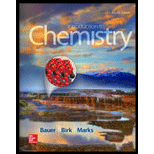
Concept explainers
Interpretation:
The molarity of the sulfuric acid solution is to be determined.
Concept Introduction:
Molarity
Percent by mass concentration is the amount (in grams) of solute present in grams of solution multiplied by 100%.
Answer to Problem 110QP
Solution:
The molarity of given sulfuric acid solution is
Explanation of Solution
Given Information:
Percent by mass concentration of
Substitute mass percentage as
The density
Substitute
Thus, the volume of
Now,
So,
Thus, the weight of Sulphuric acid in
The molar mass of
Substitute
Now, substitute
The molarity of the sulfuric acid solution is
Want to see more full solutions like this?
Chapter 11 Solutions
Introduction to Chemistry
- When 10. L of water is added to 3.0 L of 6.0 M H2SO4, what is the molarity of the resulting solution? Assume the volumes are additive.arrow_forward3.64 How many grams of solute are present in each of these solutions? (a) 37.2 mL ofO.471 M HBr (b) 113.0 L of 1.43 M Na2CO3 (c) 212 mL of 6.8 M CH3COOH (d) 1.3 × 10-4 L of 1.03 M H2S03arrow_forwardYou want to prepare a 1.0 mol/kg solution of ethyleneglycol, C2H4(OH)2, in water. Calculate the mass of ethylene glycol you would need to mix with 950. g water.arrow_forward
- What volume of 0.250 M HCI is required to neutralize each of the following solutions? a. 25.0 mL of 0.103 M sodium hydroxide, NaOH b. 50.0 mL of 0.00501 M calcium hydroxide, Ca(OH)2 c. 20.0 mL of 0.226 M ammonia, NH3 d. 15.0 mL of 0.0991 M potassium hydroxide, KOHarrow_forwardA 10.00-mL sample of a 24.00% solution of ammonium bromide (NH4Br) requires 23.41 mL of 1.200 molar silver nitrate (AgNO3) to react with all of the bromide ion present. (a) Calculate the molarity of the ammonium bromide solution. (b) Use the molarity of the solution to find the mass of ammonium bromide in 1.000 L of this solution. (c) From the percentage concentration and the answer to part b, find the mass of 1.000 L ammonium bromide solution. (d) Combine the answer to part c with the volume of 1.000 L to express the density of the ammonium bromide solution (in g/mL).arrow_forwardInsulin is a hormone that controls the use of glucose in the body. How many moles of insulin are required to make up 28 mL of 0.0048 M insulin solution?arrow_forward
- What is the molarity of pure water with a density of 1.00 g/mL?arrow_forward3.61 Calculate the molarity of each of the following solutions. (a) 1.45 mol HCl in 250. mL of solution (b) 14.3 mol NaOH in 3.4 L of solution (c) 0.341 mol KCl in 100.0 mL of solution (d) 250 mol NaNO3 in 350 L of solutionarrow_forward
 Introductory Chemistry: A FoundationChemistryISBN:9781337399425Author:Steven S. Zumdahl, Donald J. DeCostePublisher:Cengage Learning
Introductory Chemistry: A FoundationChemistryISBN:9781337399425Author:Steven S. Zumdahl, Donald J. DeCostePublisher:Cengage Learning Chemistry: The Molecular ScienceChemistryISBN:9781285199047Author:John W. Moore, Conrad L. StanitskiPublisher:Cengage Learning
Chemistry: The Molecular ScienceChemistryISBN:9781285199047Author:John W. Moore, Conrad L. StanitskiPublisher:Cengage Learning General Chemistry - Standalone book (MindTap Cour...ChemistryISBN:9781305580343Author:Steven D. Gammon, Ebbing, Darrell Ebbing, Steven D., Darrell; Gammon, Darrell Ebbing; Steven D. Gammon, Darrell D.; Gammon, Ebbing; Steven D. Gammon; DarrellPublisher:Cengage Learning
General Chemistry - Standalone book (MindTap Cour...ChemistryISBN:9781305580343Author:Steven D. Gammon, Ebbing, Darrell Ebbing, Steven D., Darrell; Gammon, Darrell Ebbing; Steven D. Gammon, Darrell D.; Gammon, Ebbing; Steven D. Gammon; DarrellPublisher:Cengage Learning Chemistry for Engineering StudentsChemistryISBN:9781337398909Author:Lawrence S. Brown, Tom HolmePublisher:Cengage Learning
Chemistry for Engineering StudentsChemistryISBN:9781337398909Author:Lawrence S. Brown, Tom HolmePublisher:Cengage Learning Chemistry: Principles and PracticeChemistryISBN:9780534420123Author:Daniel L. Reger, Scott R. Goode, David W. Ball, Edward MercerPublisher:Cengage Learning
Chemistry: Principles and PracticeChemistryISBN:9780534420123Author:Daniel L. Reger, Scott R. Goode, David W. Ball, Edward MercerPublisher:Cengage Learning Chemistry: Principles and ReactionsChemistryISBN:9781305079373Author:William L. Masterton, Cecile N. HurleyPublisher:Cengage Learning
Chemistry: Principles and ReactionsChemistryISBN:9781305079373Author:William L. Masterton, Cecile N. HurleyPublisher:Cengage Learning





